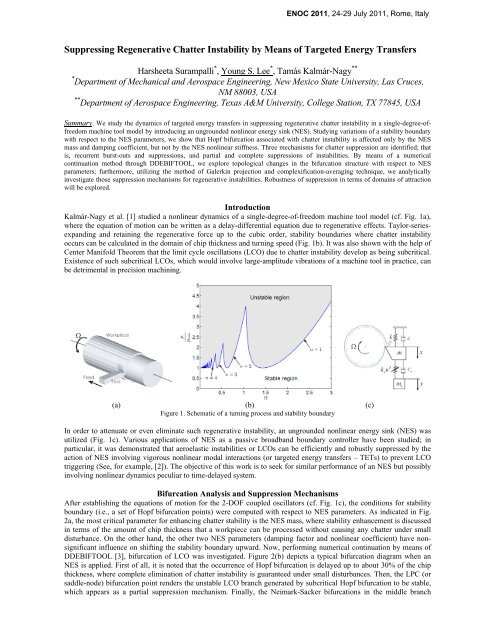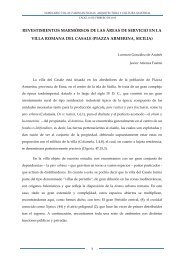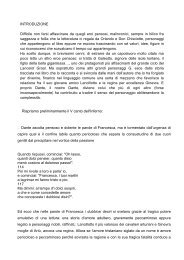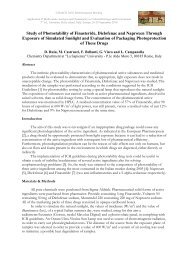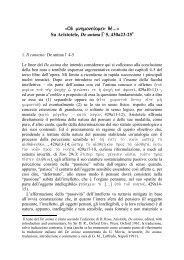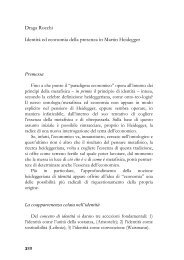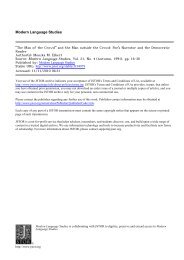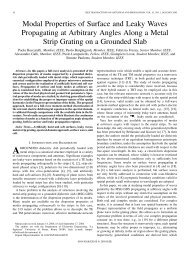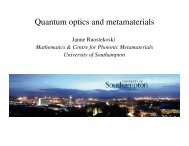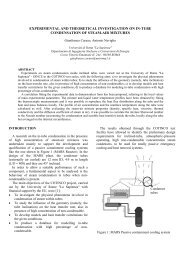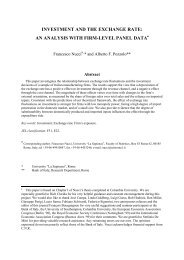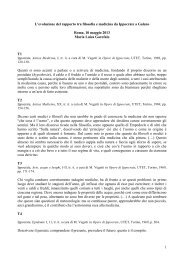Suppressing Regenerative Chatter Instability by Means of Targeted ...
Suppressing Regenerative Chatter Instability by Means of Targeted ...
Suppressing Regenerative Chatter Instability by Means of Targeted ...
You also want an ePaper? Increase the reach of your titles
YUMPU automatically turns print PDFs into web optimized ePapers that Google loves.
ENOC 2011, 24-29 July 2011, Rome, Italy<br />
<strong>Suppressing</strong> <strong>Regenerative</strong> <strong>Chatter</strong> <strong>Instability</strong> <strong>by</strong> <strong>Means</strong> <strong>of</strong> <strong>Targeted</strong> Energy Transfers<br />
Harsheeta Surampalli * , Young S. Lee * , Tamás Kalmár-Nagy **<br />
* Department <strong>of</strong> Mechanical and Aerospace Engineering, New Mexico State University, Las Cruces,<br />
NM 88003, USA<br />
** Department <strong>of</strong> Aerospace Engineering, Texas A&M University, College Station, TX 77845, USA<br />
Summary. We study the dynamics <strong>of</strong> targeted energy transfers in suppressing regenerative chatter instability in a single-degree-<strong>of</strong>freedom<br />
machine tool model <strong>by</strong> introducing an ungrounded nonlinear energy sink (NES). Studying variations <strong>of</strong> a stability boundary<br />
with respect to the NES parameters, we show that Hopf bifurcation associated with chatter instability is affected only <strong>by</strong> the NES<br />
mass and damping coefficient, but not <strong>by</strong> the NES nonlinear stiffness. Three mechanisms for chatter suppression are identified; that<br />
is, recurrent burst-outs and suppressions, and partial and complete suppressions <strong>of</strong> instabilities. By means <strong>of</strong> a numerical<br />
continuation method through DDEBIFTOOL, we explore topological changes in the bifurcation structure with respect to NES<br />
parameters; furthermore, utilizing the method <strong>of</strong> Galerkin projection and complexification-averaging technique, we analytically<br />
investigate those suppression mechanisms for regenerative instabilities. Robustness <strong>of</strong> suppression in terms <strong>of</strong> domains <strong>of</strong> attraction<br />
will be explored.<br />
Introduction<br />
Kalmár-Nagy et al. [1] studied a nonlinear dynamics <strong>of</strong> a single-degree-<strong>of</strong>-freedom machine tool model (cf. Fig. 1a),<br />
where the equation <strong>of</strong> motion can be written as a delay-differential equation due to regenerative effects. Taylor-seriesexpanding<br />
and retaining the regenerative force up to the cubic order, stability boundaries where chatter instability<br />
occurs can be calculated in the domain <strong>of</strong> chip thickness and turning speed (Fig. 1b). It was also shown with the help <strong>of</strong><br />
Center Manifold Theorem that the limit cycle oscillations (LCO) due to chatter instability develop as being subcritical.<br />
Existence <strong>of</strong> such subcritical LCOs, which would involve large-amplitude vibrations <strong>of</strong> a machine tool in practice, can<br />
be detrimental in precision machining.<br />
(a) (b) (c)<br />
Figure 1. Schematic <strong>of</strong> a turning process and stability boundary<br />
In order to attenuate or even eliminate such regenerative instability, an ungrounded nonlinear energy sink (NES) was<br />
utilized (Fig. 1c). Various applications <strong>of</strong> NES as a passive broadband boundary controller have been studied; in<br />
particular, it was demonstrated that aeroelastic instabilities or LCOs can be efficiently and robustly suppressed <strong>by</strong> the<br />
action <strong>of</strong> NES involving vigorous nonlinear modal interactions (or targeted energy transfers – TETs) to prevent LCO<br />
triggering (See, for example, [2]). The objective <strong>of</strong> this work is to seek for similar performance <strong>of</strong> an NES but possibly<br />
involving nonlinear dynamics peculiar to time-delayed system.<br />
Bifurcation Analysis and Suppression Mechanisms<br />
After establishing the equations <strong>of</strong> motion for the 2-DOF coupled oscillators (cf. Fig. 1c), the conditions for stability<br />
boundary (i.e., a set <strong>of</strong> Hopf bifurcation points) were computed with respect to NES parameters. As indicated in Fig.<br />
2a, the most critical parameter for enhancing chatter stability is the NES mass, where stability enhancement is discussed<br />
in terms <strong>of</strong> the amount <strong>of</strong> chip thickness that a workpiece can be processed without causing any chatter under small<br />
disturbance. On the other hand, the other two NES parameters (damping factor and nonlinear coefficient) have nonsignificant<br />
influence on shifting the stability boundary upward. Now, performing numerical continuation <strong>by</strong> means <strong>of</strong><br />
DDEBIFTOOL [3], bifurcation <strong>of</strong> LCO was investigated. Figure 2(b) depicts a typical bifurcation diagram when an<br />
NES is applied. First <strong>of</strong> all, it is noted that the occurrence <strong>of</strong> Hopf bifurcation is delayed up to about 30% <strong>of</strong> the chip<br />
thickness, where complete elimination <strong>of</strong> chatter instability is guaranteed under small disturbances. Then, the LPC (or<br />
saddle-node) bifurcation point renders the unstable LCO branch generated <strong>by</strong> subcritical Hopf bifurcation to be stable,<br />
which appears as a partial suppression mechanism. Finally, the Neimark-Sacker bifurcations in the middle branch
ENOC 2011, 24-29 July 2011, Rome, Italy<br />
indicate quasiperiodic responses or recurrent burst-outs and suppressions <strong>of</strong> chatter instability. Typical time responses<br />
are depicted in Fig. 3, where instantaneous frequency (as wavelet transform spectra) and modal energy exchange are<br />
considered. Indeed, all the three suppression mechanisms studied in aeroelastic applications [2] can be observed, and<br />
therefore, similar interpretation <strong>of</strong> dynamics can be made.<br />
(a) (b)<br />
Figure 2. Effects <strong>of</strong> NES: (a) Shift-up <strong>of</strong> stability boundary (i.e., Hopf bifurcation point); (b) bifurcation diagram <strong>of</strong> the tool and NES<br />
displacements for 2.6 and the NES parameters 0.2, 1<br />
0.1, C 0.5 (H, LPC and NS denote Hopf, limit point cycle,<br />
Neimark-Sacker bifurcation points, respectively; DDEBIFTOOL was implemented).<br />
Figure 3. Typical responses for recurrent burst-outs and suppressions <strong>of</strong> chatter instability for the NES parameters in Fig. 2b. Zero<br />
initial conditions except for the tool displacement <strong>of</strong> 0.5 were used.<br />
Concluding Remarks<br />
<strong>Suppressing</strong> chatter instabilities <strong>by</strong> means <strong>of</strong> targeted energy transfers was studied <strong>by</strong> applying an ungrounded<br />
nonlinear energy sink to a single-DOF machine tool model with truncated regenerative nonlinearities. Three<br />
suppression mechanisms were identified, which are closely related with the topological structure <strong>of</strong> bifurcation<br />
phenomena. An example for the suppression mechanism involving recurrent burst-outs and suppressions <strong>of</strong> chatter<br />
instability was presented, where the instantaneous frequency and energy evidenced nonlinear modal interactions (i.e., a<br />
series <strong>of</strong> 1:1 transient resonance captures and escapes from resonance) between the tool and the NES.<br />
Acknowledgment<br />
This work was supported in part <strong>by</strong> National Science Foundation <strong>of</strong> United States, Grant Numbers CMMI-0928062 (YL)<br />
and CMMI-0846783 (TK).<br />
References<br />
[1] Kalmár-Nagy T., Stépán G., Moon F.C. (2001) Subcritical Hopf Bifurcation in the Delay Equation Model for Machine Tool Vibrations. Nonlinear<br />
Dynamics 26:121-142.<br />
[2] Lee Y.S., Vakakis A.F., Bergman L.A. McFarland D.M., Kerschen G. (2007) Suppression <strong>of</strong> Aeroelastic <strong>Instability</strong> <strong>by</strong> <strong>Means</strong> <strong>of</strong> Broadband Passive<br />
<strong>Targeted</strong> Energy Transfers, Part I: Theory. AIAA Journal 45(3): 693-711.<br />
[3] Engelborghs K., Luzyanina T., Roose D. (2002) Numerical Bifurcation Analysis <strong>of</strong> Delay Differential Equations using DDE-BIFTOOL. ACM<br />
Transactions on Mathematical S<strong>of</strong>tware 28(1): 1-21.


